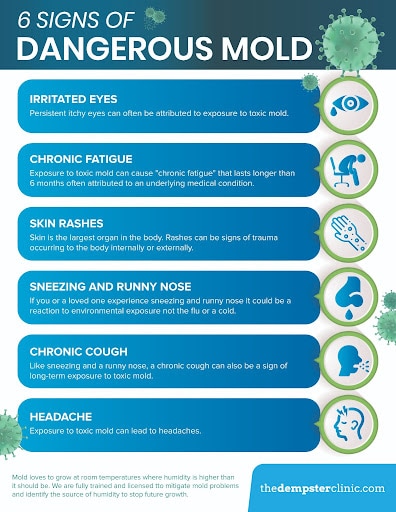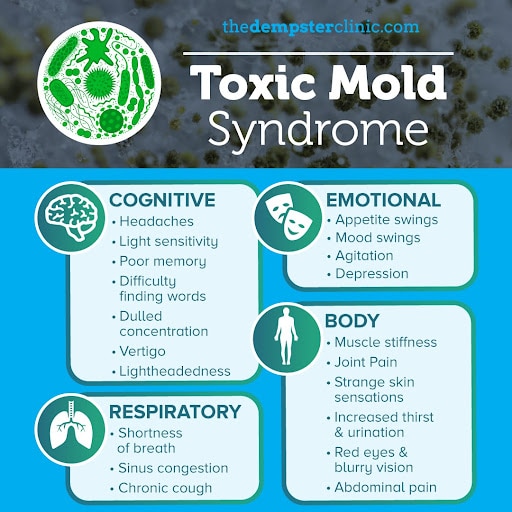Most humans have a natural aversion to the sight and even thought of moldy food. This must be an example of a natural defense mechanism humans have developed over the centuries to these often poisonous and even lethal microorganisms.
Interestingly, molds have been making human lives miserable since the dawn of time. The earliest written record of grain mold dates back to 600 BCE. Even the Bible mentions some mold-related diseases and right ways of getting rid of these deadly organisms. Possibly one of the most shocking mold-related epidemics happened in 1944 in Russia when 100,000 people died from eating moldy bread. Today mold-related deaths aren’t as common, but these potentially toxic compounds are still around, lurking unnoticed in wet parts of our environment. So what are they and what can we do to protect ourselves from deadly effects of these omnipresent organisms?
what is mold anyway?
Mold is a form of fungus that produces spores and can be found literally everywhere. Getting rid of indoor spores is practically impossible and the bad news is that they grow in the presence of even small amounts of water. This means that moist areas like the bathroom, basement, carpets and sinks are where molds thrive.
In addition to spores, molds also produce toxic compounds called mycotoxins. They are more common in different types of crops and food sources like cereals, corn, nuts, dried fruits, coffee beans and spices. It is a common misconception that cooking food can easily kill the mold. Unfortunately, temperature and majority of the conventional cooking techniques, including frying and boiling won’t solve the problem.
While spores can cause mold-induced asthma, allergic fungal sinusitis and several other diseases, mycotoxins can lead to even more serious conditions:
- Aflatoxin, found in crops, spices and tree nuts, is possibly the most poisonous of the mycotoxins. It can damage the DNA and even cause liver cancer.
- Ochratoxin A, found in cereal products and dried fruit, is linked to kidney damage in humans. There are also studies suggesting that it has negative effects on fetal development and immune system in animals.
- Patulin, found in apples and various moldy fruits, has caused symptoms like nausea, gastrointestinal disturbances and vomiting in patients.
A bunch of mycotoxins are also linked to neurological problems, causing decline in cognitive function and tremors.
Developed countries tend to have stricter control when it comes to mycotoxin content in food, however, I recommend that my patients:
- Pay attention to the appearance of the food that have a high risk of contamination
- Purchase the freshest possible grains and nuts
- Pay attention to food packaging and storing conditions
- Consume perishable food as soon as possible after purchase
Turns out age, weight, other infectious agents, sex, quantity of toxins exposed and diet are some of the factors that can worsen the effects of mycotoxins. For example, young people and children are more affected by mycotoxins than adults. Also, conditions like “vitamin deficiency, low calorie intake, alcohol abuse, or the presence of an infectious disease” can significantly increase the severity of mycotoxin related poisoning.
An unexpected source of toxicity
Natural cataclysms like flooding and hurricanes are devastating for communities for many obvious reasons, but one of the aspects that is often overlooked when taking care of flood victims is water-exposure-related mold infection – a serious condition that is hard to diagnose and often life-threatening. This was brought to attention less than a year after the infamous Hurricane Katrina, when CDC published a report called Mold Prevention Strategies and Possible Health Effects in the Aftermath of Hurricanes and Major Floods saying that exposure to mold-contaminated materials caused health problems regardless of the type of molds or the level of exposure.
Developing a mold infection doesn’t require something as dramatic as a flood. It can happen in the comforts of our homes and offices and turn our lives upside down.
SYMPTOMS AND CONSEQUENCES OF MOLD EXPOSURE

The primary target of mold is the respiratory system. Actually, one of the most overlooked causes of asthma is prolonged exposure to molds. In 2007, EPA estimated that from 21.8 million asthma cases in the US, around 4.6 million were related to mold exposure at home. The numbers have only grown since then. Inhaling mold spores can prompt the immune system to overreact and cause asthma attacks, requiring immediate medical attention. Early exposure of infants to mold increases the risk of becoming asthmatic nearly three times.

The housing situation across the world, including North America, only exacerbates this problem. In 2017, 45 million buildings in the US were estimated to have an excessive level of mold. Poor ventilation, high humidity and excess moisture are all conditions that support development of mold allergy.
WHAT CAN WE DO?
1. Eliminate The Source
In case of visible signs of mold, immediately contact the professional cleaning services to make your house mold free. It is important to allow outside air to flow into the home. This prevents the indoor air from becoming oversaturated with contaminants. Pay special attention to wet areas at home and take steps to get rid of the moisture.
- Be aware of possible symptoms
The following symptoms can be indicating that you are exposed to mold: fever, sinus problems, itchiness in eyes, nose and throat, cough, weight loss, blisters or ulcers or dryness on skin, shortness of breath.
Also, if you are experiencing symptoms related to the body’s immune response – redness, swelling, increased heat, pain, loss of function, fatigue, fever, chest or abdominal pain – this can be a sign of defense response to mold or mold-related toxins.
The Dempster Clinic provides an inflammation assessment where blood work is drawn and sent to a lab for analysis. This way we can analyze and identify inflammation that may be contributing or leading to a condition.
- Find a competent healthcare practitioner
Unfortunately, most doctors aren’t even aware of mold-related illnesses. And since these symptoms are also common in case of many other conditions, it becomes hard for them to identify the root cause and give you appropriate treatment. This can leave many patients frustrated for years.
- If your symptoms are persistent, get tested.
In addition to inflammation assessment, there are other diagnosing tests that can be done to determine if your asthma and allergies are mold-related. This includes studying the culture of specimens from the affected area, blood tests, CT for respiratory symptoms, immunotherapy, etc. There is also a radioallergosorbent test which can test your immune system’s response to mold to determine your sensitivity to specific types of mold. According to the CDC, early treatment can prevent deaths.
If you are interested in learning more ways to test for mold-induced conditions, prevent disease and feel as healthy as possible, then I encourage you to schedule an appointment at my clinic. At The Dempster Clinic – Center for Functional Medicine, I will partner with you to analyse your specific needs and address any other health concerns.
Please take advantage of my Complimentary 15-minute Discovery Session, which is available for all prospective patients. This session can take place over the phone or at the clinic in person. It gives you a chance to learn more about the services I offer and how they can help you find your best health.
Dr. John Dempster BSc., ND, FAAFM


